Virat Kohli 7/10

IMAGE: India's captain Virat Kohli celebrates after completing a century during the first Test against the West Indies. Photograph: WICB Media
India's captain started the series with a bang; a top-class knock of 200 -- his maiden double century in Tests -- that helped the visitors rout the West Indies by an innings and 92 runs.
But he failed to sustain the momentum and live up to his top billing in the rest of the series, scoring just 44, 3 and 4 in his next three innings.
Kohli's captaincy also came in for a bit of criticism after he was unable to force a result in the second Test when the West Indies played out the fifth and final day in Kingston, losing just two wickets in three sessions.
The decision to leave out Murali Vijay, India's most consistent batsman in Tests in the last couple of years, for the third Test also did not go well with Indian fans.
That he finished as the top run-getter in the four-match series with 251 runs from four innings, at an average of 62, was only because of his double hundred in the first Test.
Ajinkya Rahane 7/10
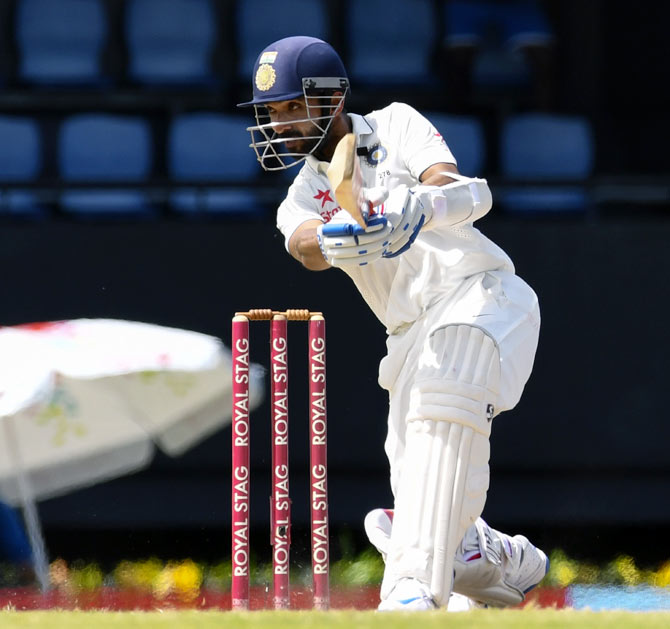
IMAGE: India vice-captain Ajinkya Rahane hits through the off-side. Photograph: WICB Media
Ajinkya Rahane continues to be India's most consistent batsman in Test cricket, especially overseas.
He played a good innings of 108 not out in the second Test and followed it up with another unbeaten knock of 78 in the next match.
The century was Rahane's fifth away from home out of total of seven Test hundreds so far. The right-hander has hit a century in five of the seven Test-playing countries -- Australia, England, New Zealand, Sri Lanka and the West Indies. He narrowly missed a century both in South Africa and Bangladesh -- scoring 96 in the Durban Test in 2013 and 98 in Fatullah last year.
India's vice-captain scored 243 runs in the series, with a whopping average of 121, and was second to Kohli in the run-scoring chart.
KL Rahul 8/10

IMAGE: India opener K L Rahul bats. Photograph: WICB Media
When the opportunity arises, grab it with both hands. That is precisely what young opener K L Rahul did in the West Indies.
An injury to Murali Vijay paved the way for the 24-year-old's inclusion and he made most of the opportunity by scoring a career-best 158 in the second Test in Jamaica.
That knock saw him being preferred ahead of Vijay for the next match and he kept his form going, hitting a fluent half-century in Gros Islet.
The Karnakata opener tallied 236 runs in three innings, at an average of 78, and looks set to get a long run at the top of the order.
Shikhar Dhawan 4/10

IMAGE: Shikhar Dhawan walks back after his dismissal. Photograph: WICB Media
Shikhar Dhawan started the series brightly, with a sparkling innings of 84 in the first Test, but his form took a sharp dip after that.He was unable to cross the 30-run mark in his next three innings and promptly dropped for the fourth and final Test in Trinidad.
Despite the inexperienced West Indies bowling attack on the slow pitches hardly posing much of a threat, Dhawan was unable to make most of his chances and finished with just 138 runs in four innings, at an an average of 34.50.
Murali Vijay 5/10

IMAGE: Opener Murali Vijay defends a short ball. Photograph: BCCI
It would be harsh to rate Murali Vijay, who got just one opportunity to bat in the series. He scored just seven in the first innings of the first Test in Antigua.
After that he got injured and was dropped for the next two Tests.
He returned to the playing eleven for the fourth and final match but poor ground conditions meant he again did not get a chance to bat.
Rohit Sharma 4/10
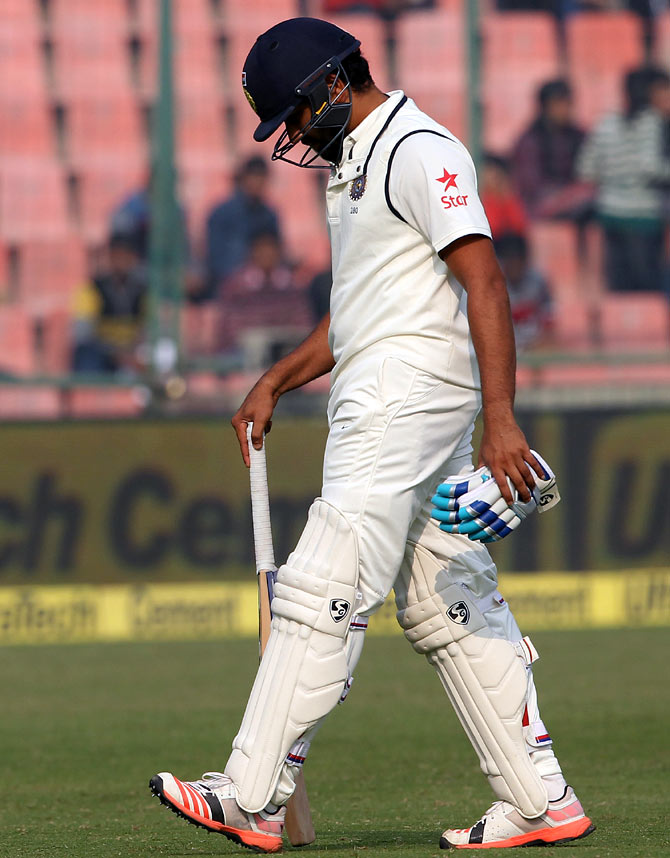
IMAGE: Rohit Sharma walks back after his dismissal. Photograph: BCCI
Rohit Sharma continues to be an enigma as far as Test cricket is concerned. He was preferred ahead of Test specialist Cheteshwar Pujara for the third Test in Gros Islet but India's most exciting player in limited-overs' cricket failed to turn it on in the longer format.
He scored nine in the first innings and threw away a start in the second. He was actually unlucky to be given out LBW off pacer Miguel Cummins despite an inside edge after scoring 41 and looking good for more.
India even tinkered with the batting order to accomodate Rohit at No. 5. However, he was unable to live up to expectations.
Cheteshwar Pujara 5/10

IMAGE: Cheteshwar Pujara plays a defensive shot. Photograph: WICB Media
Test specialist Cheteshwar Pujara has struggled to make a mark in the longer format and, not surprisingly, his name comes up first on the chopping block when changes are made to the batting order.
He failed to make a mark in the two warm-up games ahead of the Test series and in the two innings he played scored just 46 and 16 before being dropped for the third match.
Pujara's biggest drawback is his inability to force the pace. Despite spending considerable time at the crease, he never got going. He spent just under four hours at the crease during the second Test, scoring 46 from 159 balls, before being unfortunately run-out while going for a quick single.
He did return for the fourth and final Test but, unfortunately, the weather played a part in robbing him of another opportunity to prove his case.
Wriddhiman Saha 7/10
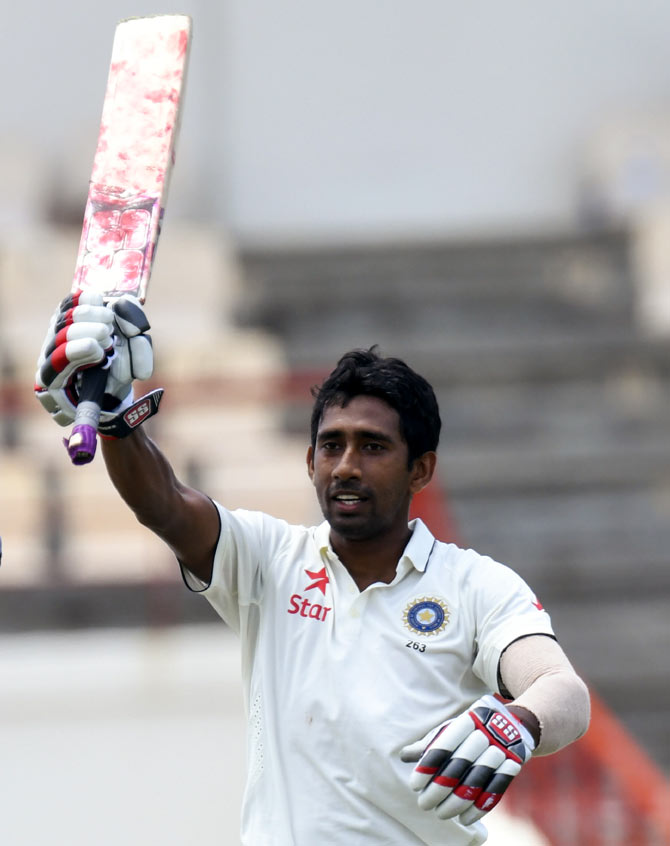
IMAGE: Wriddhiman Saha celebrates his century during the third Test. Photograph: WICB Media
Virat Kohli has always backed wicketkeeper-batsman Wriddhiman Saha since he took over from Mahendra Singh Dhoni behind the stumps. And the Bengal wicketkeeper has repaid his captain's trust in full with good performances with both, bat and gloves.
With India opting to play five bowlers, Saha was needed to make sizeable contributions with the bat and he played his part to perfection.
He scored 40 and 47 in the first two Tests before hitting a century (104) in the third, putting on a match-turning partnership of 213 runs for the sixth wicket with Ravichandran Ashwin, after India were reeling at 126 for five at one stage.
Saha's glovework was also top-notch, as he claimed nine catches and two stumpings, to add to his tally of 205 runs, at an average of 51.
. 'It was pleasing to see him step up; his coming good was the biggest positive series for me,' said Kohli, after the series.
Ravichandran Ashwin 10/10

IMAGE: Ravichandran Ashwin celebrates after scoring a century during the first Test match. Photograph: WICB Media
Ravichandran Ashwin was easily India's best player in the series; infact, no player in the two teams even came close to matching him.
He boosted his credentials as the much-needed all-rounder for the Indian team maaking telling contributions with both bat and ball in the series.
With the ball he was obviously top class, claiming 17 wickets from seven innings, inclusive of two five-wicket hauls, in the rain-hit series. But what caught everyone's attention was his top-notch performance with the bat.
The right-hander, who was promoted to No. 6 in the series, was the only batsman from both sides to hit two centuries in the four-match series.
He scored 113 in the first match in Antigua and a solid 118 in the third for a tally of 235 runs, at an average of 58.75, to emerge the fourth highest run-getter in the series.
Ashwin is only the fourth all-rounder to register two centuries and claim two five-wicket hauls in the same Test series.
Mohammed Shami 8/10
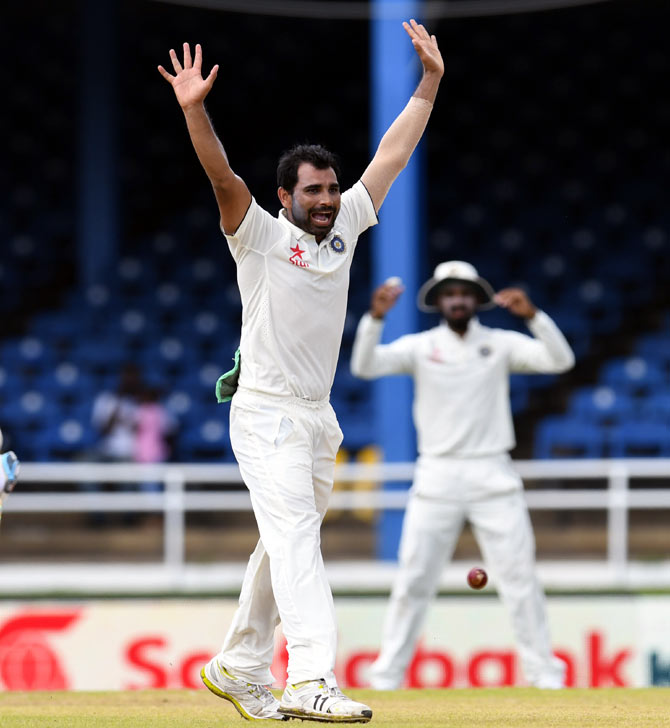
IMAGE: Fast bowler Mohammed Shami appeals for a wicket. Photograph: WICB Media
Mohammed Shami was the biggest gain for India from the series. The pacer, who spent 16 months on the sidelines with injury, made a splendid comeback to Test cricket.
He bagged 11 wickets in the series, at an average of 25.81, with a best of 4 for 92 and showed the killer instinct with the ball, something the team missed so much in his absence in the last couple of years.
He was instrumental in helping India bundle out the West Indies for 108 in the third Test after the match looked set to be heading for a draw at the end of Day 4.
Shami's addition gives the Indian bowling attack the much-needed potency.
Ishant Sharma 4/10
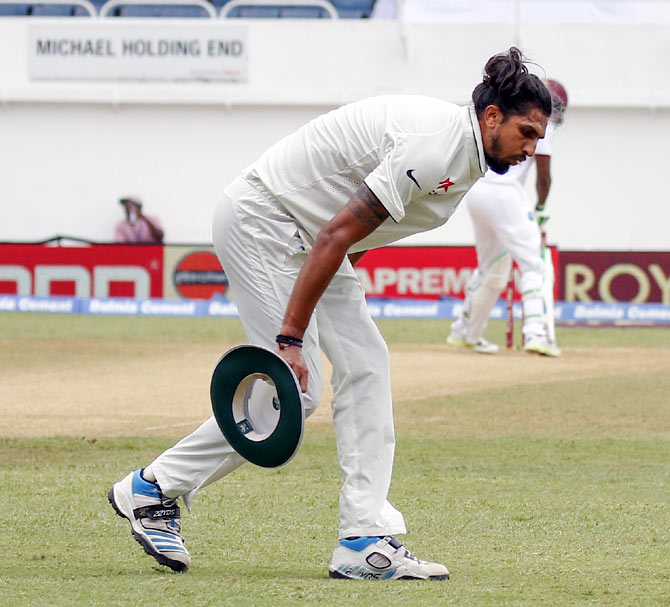
IMAGE: India pacer Ishant Sharma. Photograph: WICB Media
India's most experienced bowler again failed to deliver.
Eight wickets in seven innings, at an average of 32, against the young West Indies batting line-up is not something you expect from a player who has featured in 70-plus Tests.
The 27-year-old fast bowler was outdone by Shami, who adjusted well to the conditions and did a much better job with the ball.
Umesh Yadav 5/10

IMAGE: Umesh Yadav appeals for a wicket. Photograph: BCCI
Umesh Yadav is another fast bowler who needs to work on his consistency.
He came up with a good performance in the first match, taking five wickets (4-41, 1-34), playing a key role in India's big win.
But he went wicketless in the next match, utilised for just 18 overs after struggling against Jermaine Blackwood's attack in the first innings.
It wasn't surprising that he was not picked for the next two matches.
Amit Mishra 5/10

IMAGE: Leg-spinner Amit Mishra celebrates a wicket. Photograph: BCCI
Leg-spinner Amit Mishra is another player who needs to make most of opportunity.
He has the full backing of captain Kohli but needs to deliver with the ball to stay in contention.
He bowled quite well, taking two for 43 and one for 61 in the first match, and was unlucky not to end up with a few more wickets.
But in the second Test, he was disappointing, especially in the second innings when India were looking for a bowler to stand up after the West Indies's lower order scripted a sensational escape on Day 5.
Ravindra Jadeja 6/10

IMAGE: Ravindra Jadeja appeals for a wicket. Photograph: WICB Media
Ravindra Jadeja’s all-round abilities helped him get the nod ahead of Mishra in the third Test.
Though he did not make much of an impact with the bat, he did a steady job with the ball. In the first innings, he conceded just 27 runs in 24 overs for a wicket, while in the second innings he made two vital breakthroughs, which was instrumental in the victory.
Bhuvneshwar Kumar 7/10
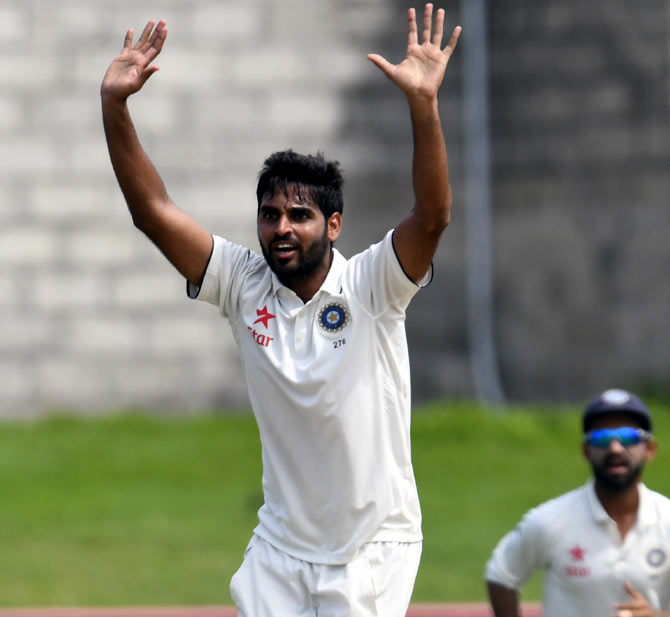
IMAGE: Bhuvneshwar Kumar appeals for a wicket. Photograph: WICB Media
He may lack in pace but when the ball starts moving there is no one better than Bhuvneshwar Kumar, as he proved in the third Test.
After the West Indies were looking comfortable on 202 for three at one stage in the first innings, Bhuvneshwar single-handedly destroyed their batting line-up to put India in pole position.
Playing his first Test in 18 months, he claimed five for 16 from a long spell of 11.4 overs that proved to be the turning point in the match.
He bowled another good spell in the second innings, taking one for 13 in 12 overs.
Bhuvneshwar was always considered as one who can be handy in seamer-friendly conditions, like in England or New Zealand, but his showing in the West Indies will certainly put him in the limelight with a long home series coming up for India.